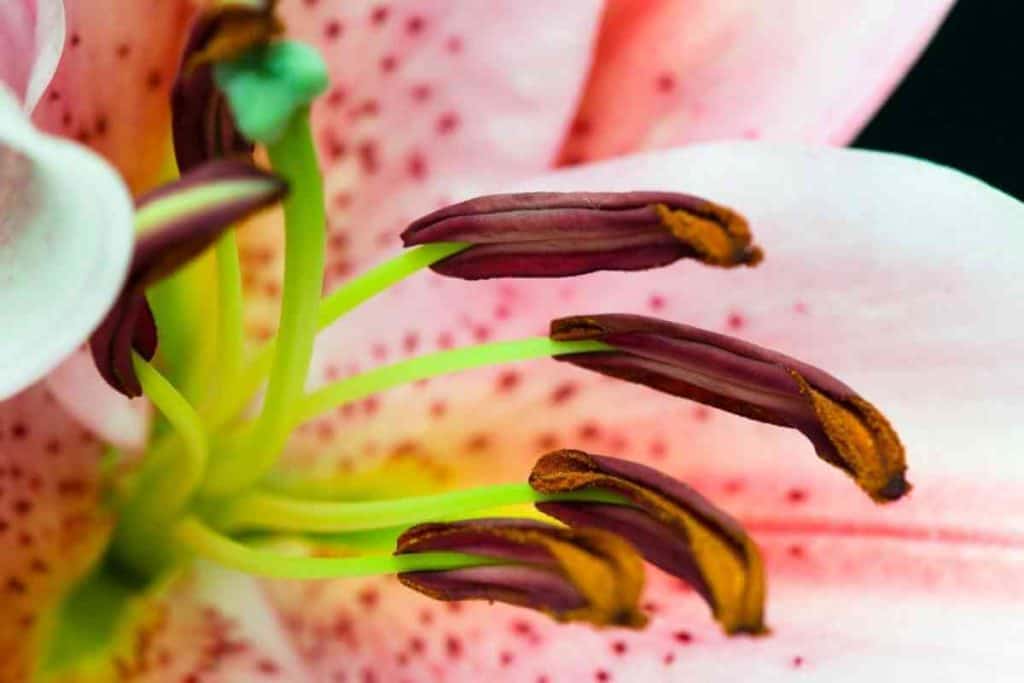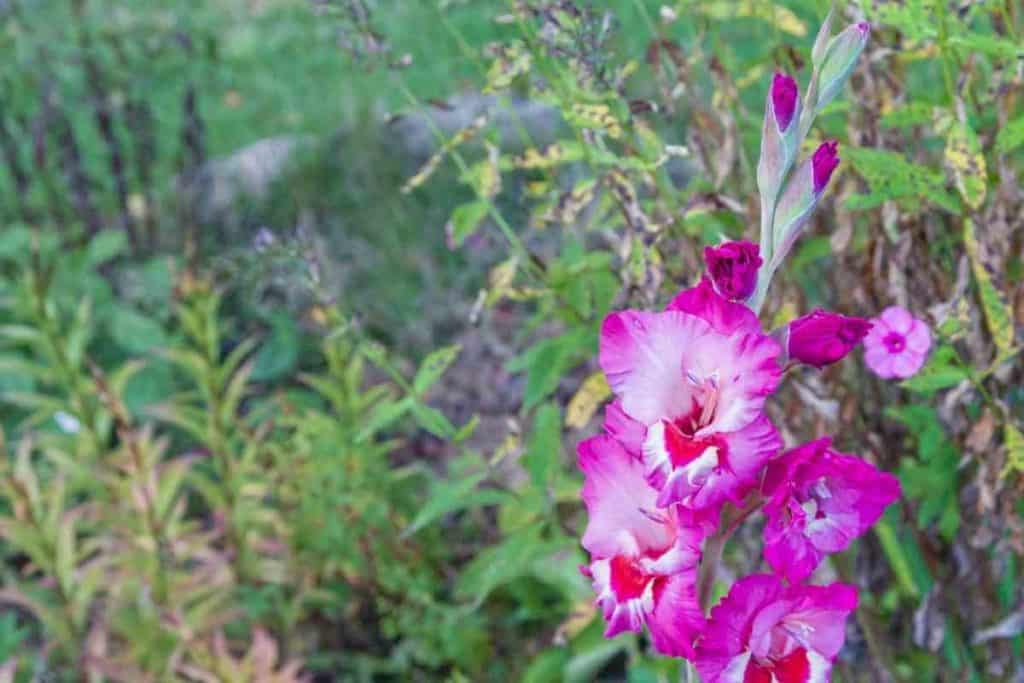If you are an experienced gardener, you’ll be familiar with the gladiolus plant, which grows elegant, 3-foot flower spikes with attractive and colorful flowers.
This bulb produces its bloom during the summer, looks very beautiful in a pot, and is perfect for growing in flower beds or gardens or vegetable gardens.
Growing and caring for the gladiolus is very easy once you follow the right maintenance routine, such as proper watering, sunlight, soil, etc.
The Gladiolus plant has different growing stages, including rooting, heading, flowering, stretching, bud formation, flower development, deadheading, and rejuvenation. It will take about 8 months for a gladiolus to grow from seeds into mature plants.
Table of Contents
What is a Gladiolus?
Widely known as ‘Glads,’ the gladiolus is a classic perennial flowering plant notable for its tall flower spikes and big colorful flowers. It comes in a range of beautiful colors, including white, yellow, pink, lavender, rose, burgundy, purple, and green.
It is a wonderful cutflower that thrives best during summer.
The gladiolus can grow up to 2 to 5ft tall, while their blooms may vary in size (from dwarf flowers that grow below 3 inches in diameter to tall ones that can reach over 5 inches). This explains why it is best for gardens with larger spaces.
The taller variety of the gladiolus flower requires staking and is usually positioned behind a garden to help complement dwarf plants.
Meanwhile, gladiolus comes from the Iridaceae family and is winter hardy in the USDA Hardiness Zones 8. The plant has different names such as flag flower, sword lily, etc., depending on how it is known in different areas.
As we earlier mentioned, gladiolus is a plant that is easy to care for and maintain, provided that you follow its care routine, such as sufficient watering, adequate lighting, and avoiding frost. Inadequate water or light will make it not bloom, or the blooms will be smaller or improperly formed.
What are Gladiolus Growing Stages?

It is important to understand the growth stages of gladiolus, including what stage they are at a particular time, as it will help you plan and time your planting accordingly.
As earlier mentioned, it will take up to 8 months for a grown gladiolus seed to get to matured or flowering stage. The following are its growing stages;
Stage 1: Proliferation – Rooting
One of the most essential parts of any plant is the rooting system, as it is very crucial in its survival and proper growth. The root ensures stability during the plant’s growth and helps the plant retain or suck up enough water and nutrients to enhance its development.
In the gladiolus growing stages, the rooting phase requires enough moisture to ensure the root develops properly. It needs a temperature that ranges from 60 to 80 degrees Fahrenheit.
Again, keep the plant where there is proper air circulation and partial shade from the effects of direct sunlight to protect its foliage.
You’ll know that the rooting stage is completed whenever the roots have occupied the pot and fail to accommodate more water or nutrients.
It may take a few weeks for the rooting stage to complete; however, immediately the root has completed its growth stage, it gives way for the stage that follows, otherwise known as foliage production.
Stage 2: Proliferation – Heading
During this period, you must keep the gladiolus in an area that receives bright indirect sunlight. It is what it requires to produce its foliage or flowers, which is why it is also called the foliage production stage.
However, excessive exposure to sunlight will only help in its leaf growth without actually producing any flower heads. The foliage production stage will take some months, but it all depends on how big you need your flower heads to become.
Just remember that letting them grow large will be unnecessary, and you will need to stake them. This phase also requires regular fertilizing, as it will help to produce strong foliage.
Nevertheless, do not over-fertilize because instead of producing flowers, it will cause them to continue growing too many leaves. Additionally, excessive fertilizer at this period without sufficient sunlight tends to weaken the flower subsequently.
Stage 3: Proliferation – Flowering

It takes around two months after heading for the gladiolus to start flowering.
At this stage, it requires full sun and out of any shelter because, with full sun, it will have enough energy that will help in its flowering. It will also increase the water quantity and fertilizer required until it produces a flower head.
Immediately, the flower heads have begun to shoot out; you can increase its water and fertilizer quantity than ever. This stage also requires sufficient warmth (a temperature of about 70 degrees Fahrenheit is perfect for encouraging flowering).
Immediately its flowering has begun, you’ll discover that it will start producing smaller leaves and in a small amount. If this occurs, it’s a sign that you should put fertilizing on hold, as over-fertilizing at this time can affect the flower colors, which usually come during its last stretch.
Stage 4: Flower Development – Stretch
The next stage is flower development, which culminates in your plant production period, and this is made possible through stretching.
However, you’ll still find few leaves left on the flower stem, but with time, they’ll all disappear. This period can take as long as 2 weeks to 3 months, depending on how long you desire your flowers to last.
It is one of the essential periods, as failure to give room for stretching or offer it excessive sunlight and heat will make the flowers produce seeds and nothing more for the whole year.
At this stage, your gladiolus needs more water but avoid giving it during the proliferation (flowering) stage.
Too much water during the proliferation stage will cause wet soil, which will signal fungal issues like crown rot. Also, make sure you avoid fertilizing at this stage because it will affect the plant’s flowering and hinder root growth subsequently.
Stage 5: Flowering – Bud Formation
After your gladiolus plant has produced flower heads, it’ll need to form buds.
You’ll encourage its bud formation when you keep it in a cooler, dark place that has less moist.
The bud formation stage doesn’t require water as in the previous stage; neither does it need direct sunlight or fertilizer to prevent much stress.
Stage 6: Flowering – Flower Development
At this stage, your gladiolus now has flowers. For more bud formation and good coloring, you’ve to minimize your watering and fertilizing rate and place the plant in a dark area.
The flowering development stage could take about two weeks, yet, you can count how many flowers are on your flower head.
If you find any brown patches around the edges of your flowers, you can spray them with fungicide because if it continues, it can affect the entire head, thereby resulting in total buds failure.
Stage 7: Flower Development – Deadheading
At this stage, don’t stop removing your spent blooms until your gladiolus starts producing new flowers. It will encourage more vigor and flowering much later during the summer.
This process is known as rejuvenation. It is the process of removal of spent blooms before they change to brown color. The perfect time for deadheading activity is in mid-morning when the flowers are tender but still open.
Don’t remove them simultaneously, as it will stall photosynthetic activities. Hence, you’ll have to exercise a little patience between each removal to enable your plant the chance to feed itself.
Stage 8: Rejuvenation
Here comes the final stage called rejuvenation.
This is when the plant is through with producing flowers for the season, which ushers in rejuvenation processes through the removal of every spent bloom before they dry up, fall off or discolor (brown, to be precise).
It’ll prevent the attraction of pests to the dead flowers.
Conclusion
As we earlier mentioned, avoid excessive removal of foliage at once, as it will hinder its photosynthetic activities via its foliage in late summer.
Therefore, minimize the number you remove during each rejuvenation scraping, which refers to eliminating old flowers without uprooting the plant too much or entirely.
Related Posts:
- Can I Leave Gladiolus Bulbs In The Ground?
- 7 Different Peony Growing Stages
- Different Soybean Growth Stages
- 4 Broccoli Growing Stages
- 4 Different Carrots Growing Stages




